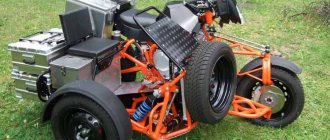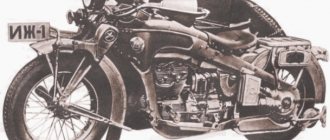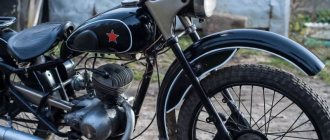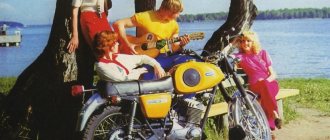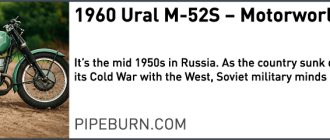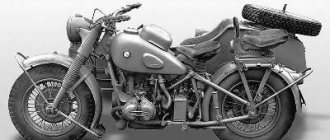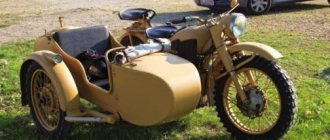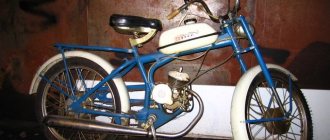Soviet motorcycles for ShKMG, part 26: High tech 70s - Riga C series mopeds.
A new product in 1971 on the race tracks was the Riga 15C moped. Without exaggeration, we can say that this was a real breakthrough in Soviet motorsport. The 15C chassis was so successful that it lasted in racing for almost twenty years and served as the basis for subsequent models that worthily represented our country in international competitions.
The chassis of the moped was developed and manufactured at the Sarkanā zvaigzne , the engine was used by Serpukhovsky, VNII Motoprom, ShK - 50, almost “square” dimension 40X39.6 mm, developing 13.5 hp. Torque was transmitted through a dry clutch to a six-speed gearbox. A spool inlet is used.
Appearance Riga - 15C.
Oil pumps were installed on mopeds that were used in international competitions; on the remaining 15C models, lubrication was carried out through a gasoline oil mixture.
Engine for GP with separate lubrication system.
At Rigi-15C, our riders Eduard Borisenko and Alexander Smertin competed at the World Championships in the GDR in 1972 and took seventh and eleventh places, respectively.
Eduard Borisenko, 1972, Sachsenring GP.
Here is the data on the Riga-15C chassis. These figures will be true for all subsequent models of Riga racing mopeds, up to 21C. Dimensions: length - 1848 mm; width (along the steering wheel) - 450 mm; height (along the fairing) - 885 mm; base - 1280 mm; front fork angle - 26°; maximum roll angle left and right - 50°; frontal area - 0.286 m2; tire size: front wheel - 2.00-18, rear wheel - 2.25-18.
Riga - 15C on the highway.
During the production of the 15C, changes were made to its design. For example, four-pad, four-cam open-type front brakes appeared.
The exposed front dual brake is a piece of engineering.
Riga - 15C with a modernized front brake.
In total, about 20 Riga-15C mopeds were produced.
The next model was Riga - 17C from 1976. The main difference is the water-cooled engine. There was no pump in the design; the cooling system was built on the so-called thermosiphon principle.
Classic look of Riga - 17C, thermosiphon cooling system.
Engine power increased to 16.5 hp. at 15000 rpm. Now let's imagine an engine with a liter power of 330 hp. and this is in 1976! An amazing achievement, on par with the world's best examples. Compression ratio 13 units, fuel - a mixture of AI-98 gasoline and oil (25: 1); The ignition system is electronic non-contact.
An aluminum cylinder with a cast iron sleeve pressed into it. Experiments were carried out with an aluminum cylinder coated with Nikasil. The aluminum piston has one flat steel ring. The connecting rod bearings are needle bearings, in the upper head there is bulk or with an aluminum cage, the lower one with a steel cage. Transmission: clutch - dry, multi-disc; forward gear - chain (3.47); gearbox - six-speed (gear ratios, respectively: I - 2.220; II - G.650; III - 1.367; IV - 1.200; V - 1.095; VI - 1.045); reverse gear - chain, gear ratio - 2.467, or 2.533, or 2.600, or 2.667, or 2.733.
Riga - 17C.
The tail, tank, fairing are made of plastic. Dry weight was 62.3 kg. Maximum speed - 153 km/h; braking distance from a speed of 60 km/h - 14 m. from 100 km/h - 48 m; fuel reserve - 8 liters. Crew part: frame - tubular, spinal; front fork - telescopic, with hydraulic shock absorber; rear fork - lever, made of rectangular steel pipes; brakes - drum.
The next model is Riga - 19C from 1978. There is no exact data on how it differs from the 17C; one can only assume that the cooling system has been modernized and a water pump driven by an electric motor has been introduced into the design.
Riga engine - 19C. The oil and water pumps are visible.
Undressed Riga - 19C. The front brake is a closed type, it is not clear how it ended up here. Once again, I’ll make a reservation that the division into 17C and 19C is conditional, since it is not known exactly what the features and differences of these models are.
Riga series C on the Riga circuit, driver Edvins Labeckis.
Riga S flies along the track in a deep tilt. You have to be a desperate person to ride at 150 km/h on such a small and light moped.
Of course, racing equipment was intensively modernized both by the plant itself and by the racers within the framework of existing rules. In old photographs you can see mopeds with Siauliai engines -
Riga series C, engine V - 501M.
Another such moped, the Vairas engine head is visible. Mopeds with such two-speed motors were used in junior competitions. Of course, there were not enough such mopeds for everyone who wanted them; there were other options, for example, homemade designs.
An example of such a homemade design, parts from road mopeds were used.
The “featherbed” frame is made for the V-501 motor, appreciate the beauty of the design and the quality of workmanship. But this is a homemade moped created by enthusiasts.
An amazing fact, but the Riga-15C chassis was also used in the 125 cc class.
Motorcycle with Riga - 15C crew part and 125 cc engine.
Moreover, this was not the first such motorcycle. There is a photo in which a 125 cc engine is installed in the chassis of the Riga-11C. unknown origin - homemade or Serpukhov. Eduard Borisenko performed there.
Motorcycle with 125 cc air-cooled engine. in the chassis Riga - 11C.
In 1983, in the magazine “Behind the Wheel”, the head of the design bureau of sports motorcycles at the Sarkana Zvaigzne plant, V. Kleinberg, announced the release of a new model Riga - 21C. Externally, it can be distinguished from the previous model by its cast wheels. Magnesium alloy wheels were cast in Leningrad, after which they were processed at the Vihur plant in Tallinn and arrived in finished form in Riga.
Riga - 21C. Judging by the photo, the women were delighted with such a moped.
Engine power was increased to 18 hp / 13.2 kW.
Riga - 21C.
The last racing motorcycle of Sarkanā zvaigzne was the Riga-23C. Three of these motorcycles were made, one with a steel frame and two with aluminum.
Riga 23C with aluminum frame…
...and with steel.
Engine Riga - 23C.
Riga - 23C, driven by Raimonds Aizstrauts, 1984.
Ainārs Karro and Raimonds Aizstrauts, 1987.
The power of the 125 cc Riga - 23C engine was 41 hp. at 14500 rpm. Sports achievements of Riga 23C - four USSR championship titles from 1983 to 1986 and silver in 1987. At the USSR Championship we had to compete with our best racing motorcycles - Vikhur with Rotax engines. At international competitions in the fight against foreign cars, the best achievement was fourth place in 1987. The author of these achievements is one of the best racers of the USSR from Riga, Raimonds Aizstrauts.
Finally, as usual, let's see which of these mopeds have survived to this day.
Riga 17C of connoisseur and collector of Soviet racing equipment Martijn Stehouwer from the Netherlands. In great shape, still racing.
Riga - 17C from the Netherlands, currently for sale on Ebay.
Riga - 15C from Japan. It is unknown how the wind blew it there.
Riga - 17C from the collection of MOMU Mootorispordi Muuseum from Riga.
Alexander Smertev and Riga - 15C.
Kaspars Brigzne and his Riga - 15C at amateur races in Riga.
Another Kaspars Brigzne moped - Riga - 21C.
Riga - 23C Raimonds Aizstrauts. A rare shot where you can see both 23Cs with an aluminum frame. By the way, for the 2019 racing season, Raimonds plans to restore his motorcycle and take part in races, thirty years later.
Revived Riga 23C.
That's all about these amazing racing mopeds. Everyone already knows well about the sad fate of the Sarkanā zvaigzne
Raimonds Aizstrauts, Kaspars Brigzne, Tony Laan took part in the preparation of the material, thanks to them.
Peculiarities
"Riga-11" is a moped that had certain improvements compared to previous similar models. The spinal frame consists of a central pipe, to which the clamps of the front fork, motor and some other parts are welded. She became tougher and more resilient. The Soviet moped in question was the first modification equipped with a spine-type frame.
The weakest link in the vehicle's design was the wheels. However, compared to the seventh variation, they received an increased cross-section and did not deform so quickly when driving on uneven roads with potholes. The wheel design itself remains unchanged.
The high steering wheel provides a comfortable driving position and is secured using a pair of clamping elements with nuts. This solution allows you to quickly and reliably change its position. The clutch and front brake levers are equipped with ball-shaped tips that protect against injury when falling.
Closest competitors
Among the mopeds of that time, Riga-11 did not have many competitors in its class. Units from the same manufacturer under the indexes 7, 12 and 16 were popular. They differed from the eleventh modification in the location of the gas tank, frame structure, wheel width and some modifications to the engine. Otherwise, the mopeds were almost identical.
Of the other Soviet manufacturers producing competitive equipment, we can mention Verkhovyna. It is worth emphasizing that many spare parts for mopeds were interchangeable, easy to operate, maintain and repair.
Consumer Reviews
The owners of the equipment in question recall that “Riga-11” is a moped that has become a childhood dream come true. Its simplicity and low price, along with modernization, have become determining factors in the popularity of this transport in cities and villages throughout the country.
Among the advantages of the car are the following:
- more stable wide wheels;
- upgraded saddle;
- strong and practical moped frame.
Now users are more nostalgic for those moments when they could touch the entire mechanism with their own hands and be proud of it. In modern times, this vehicle serves primarily as a museum exhibit or a memorable rarity.

